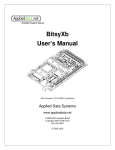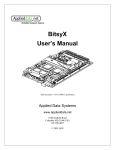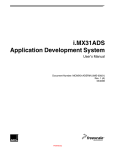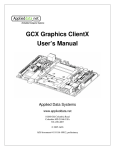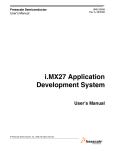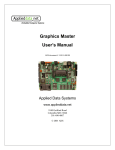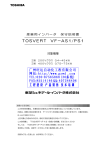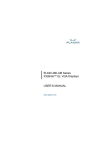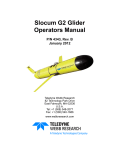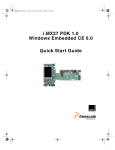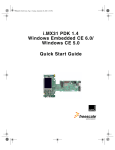Download Bitsy G5 User`s Manual - Eurotech Support Forums Topic Index
Transcript
Bitsy G5 User’s Manual ADS document # 110121-40011, preliminary Applied Data Systems 10260 Old Columbia Road Columbia MD 21046 USA 301-490-4007 www.applieddata.net © 2007 ADS Bitsy G5 User’s Manual About the Cover Image The cover image shows a revision 3 Bitsy G5. Printing this Manual This manual has been designed for printing on both sides of an 8.5x11 inch paper, but can be printed single-sided as well. It has also been optimized for use in electronic form with active cross-reference links for quick access to information. Revision History REV 1 DESCRIPTION Preliminary release of Sections 1,2,3 and 7 ADS document # 110121-40011, preliminary BY 08/09/2007 ch Page i Bitsy G5 User’s Manual (This page intentionally blank) Page ii ADS document # 110121-40011, preliminary Bitsy G5 User’s Manual Table of Contents About the Cover Image ......................................................................................................................................... i Printing this Manual .............................................................................................................................................. i Revision History.................................................................................................................................................... i Table of Contents ................................................................................................................................................ iii 1 2 3 Introduction ...................................................................................................................................... 1 1.1 Overview............................................................................................................................... 1 1.2 Features ................................................................................................................................. 1 1.2.1 Processor..................................................................................................................... 1 1.2.2 Power Supply .............................................................................................................. 1 1.2.3 Memory....................................................................................................................... 1 1.2.4 Communications ......................................................................................................... 2 1.2.5 User Interface and Display.......................................................................................... 2 1.2.6 I/O ............................................................................................................................... 2 1.2.7 Audio Interface ........................................................................................................... 2 1.3 Block Diagram ...................................................................................................................... 3 Getting Started.................................................................................................................................. 5 2.1 Development Systems........................................................................................................... 5 2.1.1 System Components.................................................................................................... 5 2.1.2 Bitsy Personality Boards............................................................................................. 5 2.2 Frequently Asked Questions ................................................................................................. 5 2.3 Organization of this Manual ................................................................................................. 6 2.4 Errata, Addenda and Further Information ............................................................................. 7 Hardware Reference ......................................................................................................................... 9 3.1 Switches, Controls and Indicators......................................................................................... 9 3.1.1 S1: DIP Switch........................................................................................................... 9 3.1.2 D9: Green LED Indicator........................................................................................... 9 3.1.3 D7: Red LED Indicator .............................................................................................. 9 3.2 Jumper Settings..................................................................................................................... 9 3.2.1 JP2: LCD Display Power Select ................................................................................ 9 3.3 Signal Connectors ............................................................................................................... 10 3.3.1 J1 (J8): LCD Panel Interface Connector .................................................................. 10 3.3.2 J2 (J3): PCMCIA ..................................................................................................... 11 3.3.3 J3 (J9): Power, I/O, Serial 2 & 3, USB, Touch Screen and others........................... 12 3.3.4 J7 (J2): I2C and SDIO/MMC.................................................................................... 13 3.3.5 J9 (J4): Expansion Bus............................................................................................. 14 ADS document # 110121-40011, preliminary Page iii Bitsy G5 User’s Manual 3.3.6 3.3.7 3.3.8 J10 (J5): ADSmartIO, USB, Serial 1, Stereo Audio, I/Os ....................................... 15 J11 (J7): Supercapacitor Input ................................................................................. 16 J16 (J1): In-System Programming ........................................................................... 16 4 Feature Reference (tbd) .................................................................................................................. 19 5 Power and Power Management (tbd) ............................................................................................. 19 6 System Specifications (tbd) ............................................................................................................ 21 7 Board Revision History .................................................................................................................. 23 Page iv 7.1 Identifying the board revision ............................................................................................. 23 7.2 Revision History ................................................................................................................. 23 7.2.1 Revision 2 ................................................................................................................. 23 New Features Changes 7.2.2 Revision 3 ................................................................................................................. 25 7.2.3 Revision A ................................................................................................................ 25 ADS document # 110121-40011, preliminary 1 Introduction 1.1 Overview The Bitsy G5 is a full-featured single board computer using the i.MX31 Multimedia Applications Processor. The Bitsy G5 is designed to meet the needs of embedded and graphical systems developers. This manual applies to the latest revision of the Bitsy G5, as listed in the revision history, section 7.2. 1.2 Features 1.2.1 Processor 1.2.2 1.2.3 • Freescale i.MX31 32-bit ARM RISC processor • ARM1136JF-S core with Vector Floating Point coprocessor and multi-level cache system • Multimedia support including VGA MPEG-4 Hardware Encoder, Image Processing Unit and Graphics Accelerator • Clock rates up to 532 MHz • Battery-backed real-time clock Power Supply • 6-15 V main power input • Freescale MC13783 Power Management and Audio Circuit Memory 1 • 128 MiB DDR SRAM 1 2 • 32 MiB NOR Flash memory 3 • PCMCIA, Type I and II, 3.3 and 5 V The Bitsy G5 supports 32, 64 or 128 MiB DDR SRAM. 2 MiB is the IEC abbreviation for mebibyte = 220 byte = 1 048 576 byte. The kibi and mebi prefixes are based on the 1998 IEC standard for binary multiples. For further reading, see the US NIST web site, http://physics.nist.gov/cuu/Units/binary.html 3 The Bitsy G5 supports 8, 16, 32 or 64 MiB of NOR flash memory. ADS document # 110121-40011, preliminary Page 1 Bitsy G5 User’s Manual 1.2.4 1.2.5 1.2.6 1.2.7 Page 2 Communications • USB 2.0 Host Port and On-The-Go (OTG) Port supporting high (480 Mbit/s), full (12 Mbit/s) and low (1.5 Mbit/s) speeds • Three Serial Ports Serial 1: EIA-232, 3.3V logic level (9-wire) Serial 2: 3.3V logic level (3-wire); IrDA and EIA-232 with optional personality board Serial 3: EIA-232, 3.3V logic level (5-wire) • Four additional EIA-232 serial ports with optional personality board • I2C bus with I2C master device • Serial Peripheral Interface (SPI) port • Secure Digital (SD/SDIO) and Multimedia Card (MMC) support • 10/100BT Ethernet, RJ45 with optional personality board • Expansion bus with optional personality board User Interface and Display • Flat Panel Interface • Software-control of external VEE Generator for passive LCD contrast control • Analog Touch Panel Interface (four- or five-wire options) • External PS/2 Keyboard Support • Nine ADSmartIOTM ports configurable for digital I/O, A/D inputs (up to four) and/or up to 4x5 keypad • Ten digital I/Os • Backlight Control Signals for Intensity and On/off • External Temperature Probe support I/O Audio Interface • Codec implemented by Freescale MC13783 Power Management and Audio Circuit • Stereo Microphone Input • Stereo 1W Speaker Outputs • Headphone Output ADS document # 110121-40011, preliminary Introduction 1.3 Block Diagram The following diagram illustrates the system organization of the Bitsy G5. Arrows generally indicate the direction of control and data flow. Connector reference designators given are for the Bitsy family products. Connector reference designators on the Bitsy G5 are labeled differently and are shown as (Jx). The diagram also illustrates a composite of the three Bitsy Personality Boards4. Connectors not found on all boards are drawn with dotted lines. See section 2.1.2 for additional details about the personality boards. Bitsy G5 Personality Board Board Power Power supply SPI2.2 RTC BATTPOS I2C USB OTG Audio I/F Codec Touch panel controller SPI2.0 xcvr COM3 SPKR MIC_IN J7 Battery (optional) J16 Power input J15 Touch panel USB Function J3 Touch Panel Controller Battery charger J3 (J9) Power Supplies J18 COM3 buffers COM2 JP4-7 PreAmp buffers IrDA digital I/Os Interfaces SPI1.1 J22 COM2 J36 Wakeup J12 Backlight BATTPOS J31 buffers J13 LCD J1 (J8) MMC J7 (J2) + LCD i.MX31 J1 MC13783 P/S2 J5 Keyboard I2C I2C I/Os PS/2 COM1 buffers SPKR amp J20 J6 J34 MIC_IN J45 digital I/Os SW1 Reset USB host buffers buffers digital I/Os Quad UART J9 System controller logic xcvr J9 (J4) DDR RAM and Flash Memory COM1 J44 J10 ADSmartIO J10 (J5) SPI1.0 System Bus I2C Ethernet J39 USB Host port J46 J47 COM4 COM5 J49 J50 COM6 COM7 PCMCIA J2 J51 (J3) 4 Personality board connectors cited in the block diagram are from the rev A Ethernet/ CompactFlash Personality Board and the rev 3 Quad UART Personality Board. ADS document # 110121-40011, preliminary Page 3 Bitsy G5 User’s Manual (This page intentionally blank) Page 4 ADS document # 110121-40011, preliminary 2 Getting Started 2.1 Development Systems Bitsy G5 boards are shipped as development systems designed to get the developer up and running quickly. To use the system, simply plug the power supply into the mini DIN-8 receptacle on the system. If the screen does not display anything after five to ten seconds, check the Frequently Asked Questions, below. Most operating systems cold boot within twenty seconds. 2.1.1 System Components A typical development system is shown at right. It consists of the following components: • Bitsy G5 single-board computer • Bitsy Personality Board • Flat panel display and cable • Backlight inverter and cable • Touch screen and cable • 100-240 VAC power adapter • Plexiglas mounting • Developer's Cable Kit including • • Serial Port DB9 adapter (ADS cable #610111-80001) • DB9F/F null modem cable • USB A-B cable Operating system of your choice • User's Guide (this document and operating system guide) Please make sure you have received all the components before you begin your development. 2.1.2 Bitsy Personality Boards The Bitsy G5 often works in tandem with another board to add functionality and customize the system for its application. Personality boards can add custom circuits and locate connectors best suited for the application design. At the time of writing, a new BitsyXb/G5 Personality Board is under development. Details are tbd. 2.2 Frequently Asked Questions The following are some of the most commonly asked questions for development systems: Q: When I plug in power, my screen is white and nothing comes up on it. A: Check the connector seating. The flat panel connector may have come loose in shipping. Press it firmly into the panel and reapply power to your system. ADS document # 110121-40011, preliminary Page 5 Bitsy G5 User’s Manual Q: Is there online support? A: Yes. Information about the Bitsy G5 hardware and software is available on the ADS support site at http://www.applieddata.net/support. See section 2.4 for further details. Q: When I plug in power, my screen stays black. A: If your system has supercapacitors installed (section 5.2.3), your system may be asleep. Try waking up the system by shorting the wakeup signal (BitsyXb J3 pin 45 or Bitsy G5 J9 pin 45) to ground. Development systems include a two-pin header on the personality board whose pins can be shorted together to wake the system. You may also press the reset button to fully restart the system. Q: When I plug in power, the LED doesn't turn on. A: Your system may still be booting. The LED is software controlled and is not necessarily turned on at boot. Q: Do I have to turn off the system before I insert a PCMCIA? A: No. The Bitsy G5 supports hot-swapping of PCMCIA cards. Consult the operating system documentation for details. Q: Do I need to observe any ESD precautions when working with the system? A: Yes. If possible, work on a grounded anti-static mat. At a minimum, touch an electrically grounded object before handling the board or touching any components on the board. Q: What do I need to start developing my application for the system? A: You will need a flash ATA card (32 MiB or larger, 128 MiB recommended) and the cables supplied with your system to interface your development station to the system. For further direction, consult the ADS guide for the installed operating system. Q: Who can I call if I need help developing my application? A: ADS provides technical support to get your development system running. For customers who establish a business relationship with ADS, we provide support to develop applications and drivers. Q: Can I upgrade the version of the operating system? A: Yes. ADS provides regular operating system updates on its developers' web site. For operating systems not maintained by ADS, contact the operating system vendor. Q: I would like to interface to a different display panel. How can I do this? A: ADS may have already interfaced to the panel you are interested in. Consult ADS for availability. 2.3 Organization of this Manual The manual organizes information in five key sections: Page 6 Introduction Provides an overview of the functionality and organization of the Bitsy G5, as well as how to use this manual. Hardware Reference Describes the configuration settings and pinouts for all connectors and jumpers on the Bitsy G5. Feature Reference Gives details about the various subsystems of the Bitsy G5. Power Management Provides key information about power management, tips for system integration and electrical and mechanical interface specifications. ADS document # 110121-40011, preliminary Getting Started Specifications Electrical and mechanical interface specifications. To locate the information you need, try the following: 2.4 1. Browse the Table of Contents. Section titles include connector designators and their function. 2. Follow cross-references between sections. 3. View and search this manual in PDF format Errata, Addenda and Further Information Errata and addenda to this manual are posted on the ADS support forums along with the latest release of the manual. Consult the support forums any time you need further information or feel information in this manual is in error. You may access the forums from the ADS support site, http://www.AppliedData.net/Support In addition to manuals, the support forums include downloads, troubleshooting guides, operating system updates and answers to hundreds of questions about developing applications for ADS products. You may also post questions you have about ADS products on the forums. ADS document # 110121-40011, preliminary Page 7 Bitsy G5 User’s Manual (This page intentionally blank) Page 8 ADS document # 110121-40011, preliminary 3 Hardware Reference This section gives an overview of the hardware features of the Bitsy G5. This overview includes a description of the switches, jumper settings, connectors and connector pinouts. Many connectors and headers have a visible number or marking on the board that indicates pin 1. If that pin is not clearly marked, there are two other ways to locate pin 1: 1. For through-hole connectors, look at the underside of the board. The square pad is pin 1. 2. Download the mechanical drawing of the Bitsy G5 available on the ADS Support site (section 2.4). The square or indicated pad on each connector is pin 1. 3.1 Switches, Controls and Indicators 3.1.1 S1: DIP Switch S1 is a two-position DIP switch located on the edge of the board at the opening of the PCMCIA socket. When in the "ON" position, switches are closed and connect to ground. Otherwise they are pulled up. DIP switch positions "1" and "2" connect to the i.MX31. Most operating systems on the Bitsy G5 reserve these switches for their use. Consult the operating system manual for details. 3.1.2 D9: Green LED Indicator The Bitsy G5 has one onboard green light-emitting diode (LED), located on the corner of the board next to JP2, that is controlled by the processor. The LED is driven by the same buffers as the display driver data lines. The LED will be off when the display buffers are disabled (see power management section 5.2.2). 3.1.3 D7: Red LED Indicator The Bitsy G5 has one onboard red LED that is connected to the MC13783 trickle LED driver output. It is located at the edge of the board under the opening of the PCMCIA socket. 3.2 Jumper Settings There is just one user-selectable jumper on the Bitsy G5. It uses a 2mm shorting block (shunt) to select the setting. Turn off power to the Bitsy G5 before changing the position of a shunt. 3.2.1 JP2: LCD Display Power Select Type: 3-post header, 2mm This jumper selects the supply voltage for the LCD display. The three-pin header is located near the PCMCIA ejector button. Jumper setting Voltage Selected 1-2 Vcc (5.0 V) 2-3 Vddx (3.3 V) WARNING! The pin out of JP2 on the Bitsy G5 is not the same as the pin out for the BitsyXb. Make sure you have selected the correct voltage before connecting the panel. Flat panels can be irreparably damaged by incorrect voltages. ADS document # 110121-40011, preliminary Page 9 Bitsy G5 User’s Manual 3.3 Signal Connectors The following tables describe the electrical signals available on the connectors of the Bitsy G5. Each section provides relevant details about the connector including part numbers, mating connectors, signal descriptions and references to related chapters. To locate pin 1 of a connector, look for numbers silk screened on the component side5 of the Bitsy G5, or look at the bottom side of a connector for the square pad, which is pin 1. As seen from the component side, doublerow headers on the board are numbered as shown in the figure to the right. 2 4 6 8... 1 3 5 7... For information about the location of the connectors on the Bitsy G5, refer to section 6.1.1. Legend: n/c GND (4.1) Not connected Bitsy G5 ground plane Reference section(s) for signals I O IO P A OC signal is an input to the system signal is an output from the system signal may be input or output power and ground analog signal open collector output Signal Types The reference designators on the Bitsy G5 are labeled differently than the previous four generations of the Bitsy family products or the mating personality board. The Bitsy family products reference designators are listed in the following sections with the reference designators on the Bitsy G5 shown as (Jx). 3.3.1 J1 (J8): LCD Panel Interface Connector Board Connector: 2x17, 2mm spacing, Samtec STMM-117-02-G-D Recommended Mating Cable: Samtec TCSD Series Recommended Board-to-Board Connector: ESQT series (e.g. ESQT-117-02-F-D-500) The following table describes the signals on the LCD interface connector. Signal names shown are for TFT active matrix color LCDs at 16 bpp (bit-per-pixel). For other color depths and LCD technologies, consult the table in section 4.6.4. Signals from the i.MX31 are buffered and RFI filtered before reaching J1 (J8). The LCD panel output buffers operate at a fixed 3.3 V. See section 4.6 for further details about displays. Pin 1 2 3 4 5 6 5 Page 10 i.MX31 Signal Name FPSHIFT HSYNC VSYNC3 Color Active TFT Display at 16bpp ADS Signal Name Description n/c GND ground PNL_PIXCLK Pixel Clock PNL_HSYNC Horizontal Sync. PNL_VSYNC Vertical Sync. GND ground The "component side" of the Bitsy G5 is the one on which the PCMCIA ejector is installed. ADS document # 110121-40011, preliminary Hardware Reference 7 8 9 10 11 12 13 14 15 16 17 18 19 20 21 22 23 24 25 26 27 28 29 30 LD12 LD13 LD14 LD15 LD16 LD17 LD6 LD7 LD8 LD9 LD10 LD11 LD0 LD1 LD2 LD3 LD4 LD5 Drdy0 Red Bit 0 Red Bit 1 Red Bit 2 Red Bit 3 Red Bit 4 Red Bit 5 ground Green Bit 0 Green Bit 1 Green Bit 2 Green Bit 3 Green Bit 4 Green Bit 5 ground Blue Bit 0 Blue Bit 1 Blue Bit 2 Blue Bit 3 Blue Bit 4 Blue Bit 5 ground Data_Enable PNL_PWR Vcc (5 V) or 3.3 V (JP2) 31 PNL_RL 32 PNL_UD 33 ADSmartIO PD0 34 3.3.2 PNL_RED0 PNL_RED1 PNL_RED2 PNL_RED3 PNL_RED4 PNL_RED5 GND PNL_GREEN0 PNL_GREEN1 PNL_GREEN2 PNL_GREEN3 PNL_GREEN4 PNL_GREEN5 GND PNL_BLUE0 PNL_BLUE1 PNL_BLUE2 PNL_BLUE3 PNL_BLUE4 PNL_BLUE5 GND PNL_LBIAS Horizontal Mode Select (set by R247 or R246) Vertical Mode Select (set by R248 or R249) PNL_ENA Panel enable signal VCON low-voltage adjust for contrast control of some displays (6.3.2) (zero to PNL_PWR volts) J2 (J3): PCMCIA Integrated ejector: FCI 95620-050CA The 68-pin PCMCIA socket conforms to the PCMCIA standard for 5V-tolerant Type II cards, and can also be run at 3.3 V. The socket is normally de-energized; the operating system is responsible for turning on the socket when a card is inserted and turning it off when the card is removed. Ejector hardware is standard. Vpp (pins 18 and 52), which is 12 V in older PCMCIA implementations, is left unconnected in this implementation. See section 6.3.7 for electrical specifications. ADS document # 110121-40011, preliminary Page 11 Bitsy G5 User’s Manual 3.3.3 J3 (J9): Power, I/O, Serial 2 & 3, USB, Touch Screen and others Board Connector: 2x25, 2mm spacing, Samtec STMM-125-02-G-D Recommended Mating Connector: Samtec TCSD Series Recommended Board-to-Board Connector: ESQT series (e.g. ESQT-125-02-F-D-500) Pin 1 3 Name EIO9 EIO8 EIO7 GND VCC 5 7 9 11 13 15 17 19 21 23 25 27 29 31 33 6 Page 12 2 4 6 8 10 TEMP_SENSOR _MINUS TEMP_SENSOR _PLUS /IRDAON TSPX TSMY TSMX TSPY EIO5 EIO6 BACKLIGHT PWM /BACKLIGHT ON RXD2T TXD2T WIPER PB0 GND PE2 CTS3 TXD3 RTS3 RXD3 USB+ USBGND HP_IN STXD SRXD SCLK2 SFRM2 Type IO IO IO PO +5 V AI External Temperature Probe Connection (4.3.5) 12 14 16 AO 18 OC 22 24 26 28 30 32 34 36 General Purpose Digital I/Os (4.7.1, 6.3.9) ground O AIO AIO AIO AIO IO IO 20 Description P PO USB_RECONN GND 35 37 39 43 Pin I O AI O P O I O O I IO IO P I 0 right top left bottom External IRDA control output UL Touch screen LR (6.3.3) LL UR General Purpose Digital I/Os (4.7.1, 6.3.9) Backlight Intensity (PWM) (4.6.6, 6.3.2) Backlight On/Off (open-collector) (4.6.6, 6.3.2) Serial 2 (3.3 V logic level) (4.5.1) Touch screen wiper (optional 5-wire touch) ADSmartIO 6 (5.2.7) ground Power Enable #2 for external devices (5.2.2) Serial 3 (EIA-232) (4.5.1) USB Client (4.5.2) ground Headphone connection (4.4.2, 6.3.8) USB Client power management 6 (4.5.2) P O I O O ground MOSI MISO SCLK SS SPI signals (4.5.3) This output does not have any series resistance or ESD protection. ADS document # 110121-40011, preliminary Hardware Reference Pin Name VBATT_POS VBATT_NEG 41 POWERENABLE /PE1 DCIN_POS 45 /RQONOFF 47 49 GND Pin 38 40 42 44 48 Type PI P O O Description External Battery Input (5.2.7) Power Supply Control Output (5.2.2) Power Enable #1 for external devices (5.2.2) PI External Power Input I "Request On/Off" Switch Input (5.2.3, 6.3.1) P ground PI Real-time clock backup battery (4.2, 6.3.4) 46 BATPOS 3.3.4 50 J7 (J2): I2C and SDIO/MMC Board Connector: 2x8, 2mm spacing, Samtec STMM-108-02-G-D-SM Recommended Board-to-Cable Connector: TCSD series Recommended Board-to-Board Connector: ESQT series (e.g. ESQT-108-02-F-D-450) 7 This header supplies the signals for the I2C (4.5.4) and SDIO/MMC (4.5.5) interfaces. See the respective sections in Chapter 4 for additional details about how the signals are used. Pin 1 2 3 4 5 6 7 8 9 10 11 12 13 14 15 16 Name I2C_SDA I2C_SCL GND SD_DAT2 SD_DAT3 SD_CMD SD_DAT0 SD_CLK /SD_CD VDDX VCC /SD_WP /SDIO_IRQ /SD_PWREN SD_DAT1 Type IO IO P P IO IO IO IO O I8 PO PO I I O IO Description I2C (4.5.4) ground SDIO/MMC signals (4.5.5) 3.3 V 5V SDIO/MMC signals (4.5.5) 7 Note that the STMM header is 0.050-inch higher than the other 2mm headers on the board because it is a surface-mount part. Use a correspondingly shorter socket on mating boards. 8 Pulled-up on Bitsy G5 with 4.7kΩ resistor. ADS document # 110121-40011, preliminary Page 13 Bitsy G5 User’s Manual 3.3.5 J9 (J4): Expansion Bus Board Connector: 2x5, 2mm spacing, Samtec STMM-125-02-G-D Recommended Mating Connector: Samtec TCSD Series Recommended Board-to-Board Connector: ESQT series (e.g. ESQT-125-02-F-D-500) These signals can be used to expand the capabilities of the Bitsy G5 as a 3.3 V digital expansion bus. See section 4.1.5 for details. Pin 1 3 5 7 9 11 13 15 17 19 21 23 25 27 29 31 33 35 37 Page 14 Name GND n/c n/c PCBD10 PCBD9 PCBD8 PCBD2 PCBD1 PCBD0 n/c n/c n/c PCBA11 VCC /CARDBWAIT CARDBRES PCBA0 PCBA1 PCBA2 PCBA3 PCBA4 PCBA5 PCBA6 n/c +3.3V /CARDBON n/c CF_/INT /CARDBMWR n/c BEB1_B PCBA7 PCBA8 PCBA9 /CARDBMRD n/c CS_CF Pin Type P Description ground 2 4 6 8 10 IO IO IO IO IO IO Data8-10 Data0-2 12 14 16 18 20 22 24 28 O PO I O O O O O O O O Address 11 5V Wait Reset Address0-6 P0 O +3.3 V 5 V Power Control I O O O O O O O Interrupt Signal Memory Write O Chip Select 26 30 32 36 34 38 IO Read Address7-9 Memory Read ADS document # 110121-40011, preliminary Hardware Reference Pin 39 41 43 45 47 49 3.3.6 Name PCBD15 PCBD14 PCBD13 PCBD12 PCBD11 PCBD7 PCBD6 PCBD5 PCBD4 PCBD3 n/c Pin Description 40 42 44 46 48 Type IO IO IO IO IO IO IO IO IO IO /CARDBON_3P3V 50 O 3.3 V Power Control Data11-15 Data3-7 J10 (J5): ADSmartIO, USB, Serial 1, Stereo Audio, I/Os Board Connector: 2x25, 2mm spacing, Samtec STMM-125-02-G-D Recommended Mating Connector: Samtec TCSD Series Recommended Board-to-Board Connector: ESQT series (e.g. ESQT-125-02-F-D-500) Pin 1 3 5 7 9 11 13 15 Name /EXT_IRQ1 /EXT_IRQ2 EIO4 EIO3 EIO2 EIO1 EIO0 SIGPS2 CLKPS2 USB_PWR_ SENSE USB_PWR_ CTRL USB_UDCUSB_UDC+ I2C_SCL SMTIO1 SMTIO0 SPKR_LSPKR_L+ SPKR_RSPKR_R+ Pin 2 4 6 8 Type I I IO IO IO IO IO IO IO 10 I 12 O 14 16 IO IO IO IO IO AO AO AO AO 18 20 22 24 Description External Interrupt 1 Input External Interrupt 2 Input General Purpose Digital I/Os (4.7.1, 6.3.9) External PS/2 keyboard inputs Sense Input from external USB host power switch (4.5.2) Discrete output to control external USB host power switch (4.5.2) USB Host (4.5.2) PC6 PD1 PD0 I2C clock 9 Thermistor energize (4.3.5) Passive panel enable (PNL_ENA) Stereo Speaker, left channel (4.4.2) Stereo Speaker, right channel (4.4.2) 9 PC6 and PC7 can be are used for the I2C bus master interface. Standard Bitsy G5 systems do not connect the ADSmartIO controller to the I2C bus. See section 4.5.4 for details. ADS document # 110121-40011, preliminary Page 15 Bitsy G5 User’s Manual Pin 17 19 21 23 25 27 29 31 33 35 37 39 41 43 45 47 Name ROW0 ROW1 ROW2 ROW3 ROW4 COL0 COL1 COL2 COL3 RI1 DCD1 DSR1 DTR1 RXD1 TXD1 CTS1 RTS1 /EXT_IRQ3 VDDX 3.3.7 26 28 30 32 34 36 38 40 Type IO IO IO IO IO IO IO IO IO I I I O I O I O I PO MIC_GND MIC_L MIC_R reserved /RESET_IN VDDX VCC 49 Pin I2C_SDA GND 42 44 46 48 ADSmartIO (see section 6.3.6) Serial 1 (EIA-232 with 3.3 V logic level volume production option) (4.5.1) External Interrupt 3 Input 3.3 V P Microphone ground AI AI Stereo Microphone Input I PO External Reset Input (6.3.1) 3.3 V PO 5V IO P 50 Description PC0 PC1 PC2 PC3 PC4 PA0 PA1 PA2 PA3 PC7 I2C data 9 ground J11 (J7): Supercapacitor Input Supercapacitors are not supported by the Bitsy G5. This socket may not be populated on all boards. 3.3.8 J16 (J1): In-System Programming Board Connector: 2x8, 2mm spacing, Samtec STMM-110-02-G-D-SM Recommended Board-to-Board Connector: ESQT series (e.g. ESQT-110-02-F-D-450) [tbd] This header is used during manufacturing for programming and test, but is not otherwise supported for application use. Production customers may use this header to reprogram boot code. Pin 1 2 3 4 5 6 Page 16 Name PM_RSTMCU_B TRSTB TMS GND TCLK GND Type I I I P I P Description Power on reset JTAG ADS document # 110121-40011, preliminary Hardware Reference Pin 7 8 9 10 11 12 13 14 15 16 17 18 19 20 Name TDI GND TDO GND RTCK 2.7V PRG VDDX MISO DE_B MOSI GND SCK GND ADS document # 110121-40011, preliminary Type I P O P O PO I PO O I I P I P Description 2.75 V ATMega/ADSmartIO 3.3 V ATMega/ADSmartIO JTAG ATMega/ADSmartIO Page 17 Bitsy G5 User’s Manual (This page intentionally blank) Page 18 ADS document # 110121-40011, preliminary 4 Feature Reference (tbd) 5 Power and Power Management (tbd) ADS document # 110121-40011, preliminary Page 19 6 System Specifications (tbd) ADS document # 110121-40011, preliminary Page 21 7 Board Revision History 7.1 Identifying the board revision The product revision number of the Bitsy G5 is etched on the underside of the printed circuit board. That number is 170121-4000x, where "x" is the board revision. 7.2 Revision History This section describes the differences between the revisions of the Bitsy G5. 7.2.1 Revision 2 Pre-production. If you are using a Bitsy G5 as a replacement for the BitsyXb, please note these differences from revision A of the BitsyXb: New Features Freescale i.MX31 processor replaces XScale PXA270. Freescale MC13783 Power Management and Audio Circuit: • Replaces discrete microphone preamp circuitry and Crystal CS4202 AC’97 stereo codec. • Replaces discrete switching regulator, linear voltage regulator and step down converters providing supply voltages for processor, memories, CPLD, and IO. • Provides 4-wire analog touch panel capability. • Replaces discrete RTC component. DDR SRAM replaces SDRAM. USB 2.0 Host port and USB 2.0 On-The-Go (OTG) port replaces USB 1.1 ports. Changes Pinout of JP2 swapped. Voltage Setting Vddx (3.3V) Vcc (5.0V) Jumper Setting From To 1-2 2-3 2-3 1-2 Connector reference designators labeled differently. In this manual, all Bitsy G5 reference designators shown as (Jx). LCD Panel Interface signals on J1 (J8) changed as follows: Pin 1 From PNL_VEE To n/c Option to operate LCD panel buffers at either 3.3 V or 5 V removed. Supports LCD display data at 3.3 V only. Series resistor removed from USB_RECONN output, J3 (J9) pin 33. ADS document # 110121-40011, preliminary Page 23 Bitsy G5 User’s Manual Input Power connector, J6, removed. Secure Digital (SD/SDIO) and Multimedia Card (MMC) not supported. Vee Adapter connector, J8, removed. External CompactFlash not supported. Connector J9 (J4) used for 3.3 V expansion bus only. Signals on J9 (J4) changed as follows: Pin 2 4 9 11 12 13 14 16 18 20 21 22 24 26 27 28 30 31 32 33 35 36 37 38 49 From /CARDBDET2 /CARDB16 CARDBSTSCHG CARDBSPK PCBA0 /CARDBREG PCBA1 PCBA2 PCBA3 PCBA4 /CARDBVS2 PCBA5 PCBA6 CARDBVCC CARDBIRQ PCBA7 PCBA8 /CARDBIOWR PCBA9 /CARDBIORD /CARDB_VS1 PCBA10 /CARDBCE2 /CARDBCE1 /CARDBDET1 To n/c n/c n/c n/c n/c PCBA11 PCBA0 PCBA1 PCBA2 PCBA3 n/c PCBA4 PCBA5 n/c CF_/INT PCBA6 PCBA7 n/c PCBA8 BEB1_B n/c PCBA9 CS_CF CS_CF n/c Battery trickle charger not supported. Signals on J3 (J9) changed as follows: Pin 22 From CHARGE To ADSmartIO PB0 Signals on J10 (J5) changed as follows: Pin 43 From VREF To Reserved Supercapacitor Input connector J11 (J7) not supported. RTC Interface changed from I2C bus to SPI. USB OTG transceiver added to I2C bus at address 010 1101. Pull up resistor value on I2C bus changed from 1.2kΩ to 2.2kΩ. Page 24 ADS document # 110121-40011, preliminary Board Revision History Crystal frequencies changed. Removed 24.576 MHz, 32.768 kHz and 13.000 MHz. Added 19.2 MHz and 26.000 MHz. Red LED added to MC13783 trickle LED driver output. ISP Port connector J16 (J1) changed from 16 pin STMM-108-02-G-D-SM to 20 pin STMM-11002-G-D-SM. Pinout changed as follows: Name /TRST TMS GND TDI TCLK VDDX GND TDO /FEW FRDY MISO VCC SCK MOSI PRG GND PM_RSTMCU_B TRSTB GND GND RTCK 2.7V DE_B GND 7.2.2 From 1 2 3 4 5 6 7 8 9 10 11 12 13 14 15 16 To 3 4 7 5 14 6 9 15 19 17 13 18 1 2 8 10 11 12 16 20 Revision 3 Initial release. Secure Digital (SD/SDIO) and Multimedia Card (MMC) supported. Pull up resistor value on /SD_CD signal, J7 (J2) pin 10, changed from 47kΩ to 4.7kΩ. 7.2.3 Revision A Production release. Available Q4 2007. ADS document # 110121-40011, preliminary Page 25 Bitsy G5 User’s Manual (This page intentionally blank) Page 26 ADS document # 110121-40011, preliminary
































